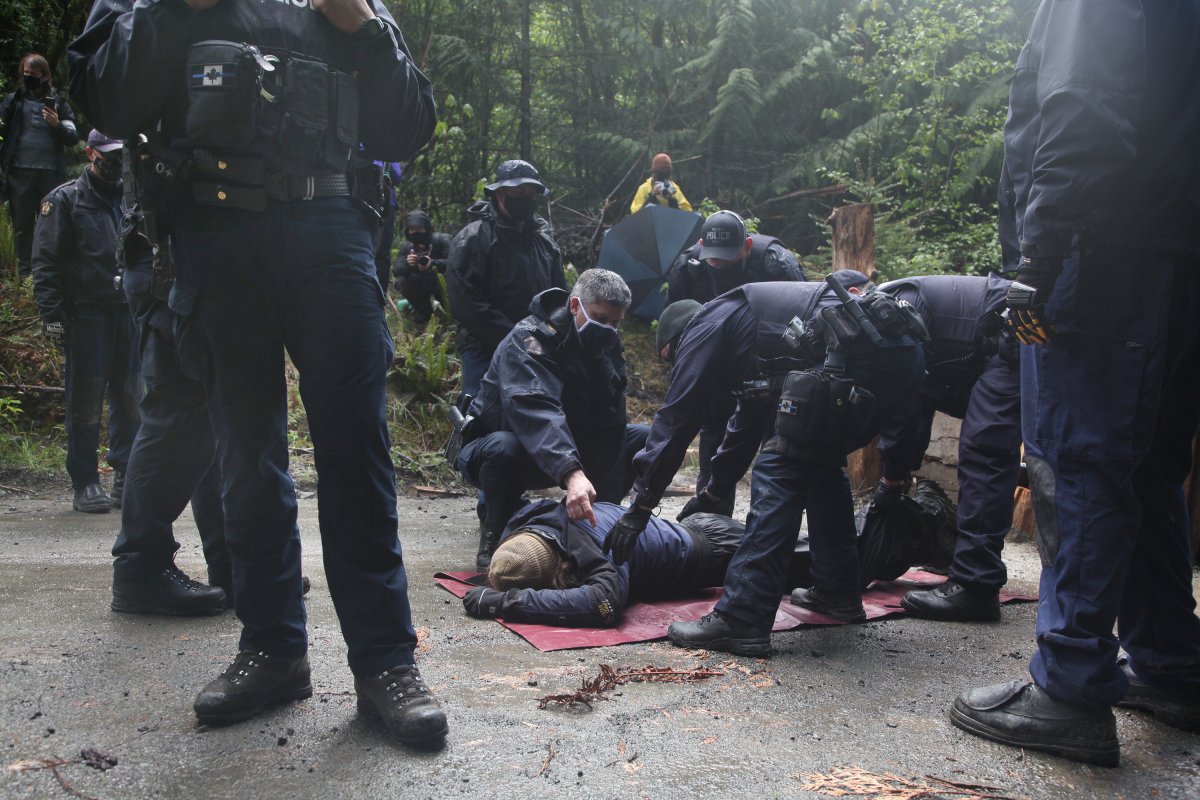Canadian politicians are great at making promises about protecting the environment. They’re not always great at keeping them.

In 2010, former Conservative prime minister Stephen Harper’s government agreed to protect 17 per cent of Canada’s land and freshwater by 2020.
At the time, just 9.6 per cent of Canada’s land and freshwater — collectively referred to as “terrestrial areas” — was protected, meaning it was safe from future development and had plans in place for safeguarding wildlife and ecosystems.
But when the Conservatives left office in 2015, protected land and waters made up just 10.6 per cent of Canada’s terrestrial areas. This figure is slightly higher — 11.3 per cent — if areas classified as “conserved” are included.

Enter Liberal Leader Justin Trudeau.
When Trudeau took office in 2015, he inherited the target set by Harper. Trudeau won that election, in part, because Canadians believed he was the right candidate to tackle climate change and protect the environment.
Trudeau then went a step further than Harper after winning the 2019 election. He instructed the ministers of environment and oceans to work collectively toward protecting 25 per cent of Canada’s terrestrial areas by 2025.
- Posters promoting ‘Steal From Loblaws Day’ are circulating. How did we get here?
- Video shows Ontario police sharing Trudeau’s location with protester, investigation launched
- Canadian food banks are on the brink: ‘This is not a sustainable situation’
- Solar eclipse eye damage: More than 160 cases reported in Ontario, Quebec
This goal was reiterated in the government’s Throne Speech in September 2020, when Trudeau pledged to protect “a quarter” of all land and freshwater in Canada.
But as of Dec. 31, 2020 — the deadline Canada set for protecting 17 per cent of its terrestrial areas — just 11.7 per cent of land and freshwater was protected. If areas classified as “conserved” are included, this figure is 12.5 per cent.
And now that the 2021 federal election is underway, both Conservative Leader Erin O’Toole and Trudeau are asking voters to trust them when they say it’ll be different this time. Meanwhile, experts say if the past is any indication of what’s to come, Canadians should be cautious.
“Governments are taking advantage of Canadians’ lack of awareness about the state of the natural environment to make easy campaign promises,” said Devon Page, executive director of EcoJustice Canada.
“The problem is that successive governments have just continued to make bigger promises and push them farther out without meeting them.”
Even bigger promises
Protecting terrestrial areas remains a pillar of both the Conservative and Liberal campaigns to win over Canadians.
O’Toole is pledging to meet the Harper-era target of protecting 17 per cent of terrestrial areas and to “work towards” the goal of protecting 25 per cent. The Conservative platform doesn’t offer a deadline for when either of these objectives will be achieved and the party didn’t provide one when asked.
“Protecting the environment has always been a core Conservative value,” said party spokesperson Chelsea Tucker.
“We need an environmental process that Canadians can trust, is not unnecessarily burdensome, and finds a balance between environmental protections and economic development.”
The Liberals, meanwhile, said they’ll protect 25 per cent of terrestrial areas by 2025 and aim to protect 30 per cent by 2030.
Global News asked the Liberals why Canadians should believe these promises when the Liberals failed to meet Canada’s previous target.
A spokesperson for the party said Canada is “on course” to reaching its objectives, but said nothing about past failures.
“We’ve (made) significant efforts and investments to protect more of our lands, including by making the two largest investments in nature conservation in Canadian history in both Budget 2018 and Budget 2021,” said Liberal spokesperson Brook Simpson.
“Because of that work and those investments, we will meet our goal.”
Both the Conservatives and Liberals are pledging billions of dollars in new funding to support environmental protection.
The Liberals’ most recent budget included $2.3 billion in promises targeted at conserving up to one million square kilometers of land and freshwater. The Liberals say they’ll spend an additional $1.7 billion on climate change-related environmental protection efforts.
The Conservatives, meanwhile, are pledging to spend $3 billion between now and 2030 on “natural climate solutions” focused on managing crops and grazing lands, and restoration of grasslands, wetlands and forests.
Both parties say they’ll work with Indigenous communities to expand areas under their protection.
The NDP and Green Party are pledging to protect 30 per cent of lands and freshwater by 2030. Both parties have said Indigenous-led conservation efforts are crucial to their plans for a greener future.
Global News asked the NDP and Green Party what, if anything, they’d do differently than the Liberals and Conservatives to ensure Canada meets its targets for protecting terrestrial areas. Neither party responded to questions by the time of publication.
Provinces control land
While it’s true Canada failed to meet its commitment to protect 17 per cent of land and freshwater by 2020, the Liberals did accomplish the goal of protecting 10 per cent of marine ecosystems.
If areas considered “conserved” are included, the Liberals increased the total area of marine ecosystems under protection to 13.8 per cent in 2020 from 1.2 per cent in 2015.
Why oceans were protected and not land could be, at least in part, due to jurisdiction, according to Sandra Schwartz, the national executive director of the Canadian Parks and Wilderness Society (CPAWS).
“Jurisdiction for conservation of land in particular really rests with the provinces and territories, and ocean protection rests predominantly with the federal government,” Schwartz said. “But of course, all levels of government need to work together to achieve these targets.”
According to the Liberals, the provinces and territories own roughly 80 per cent of Crown lands in Canada. That means they’re responsible for managing and setting aside these areas for conservation and protection.
But neither Harper nor Trudeau made these promises without knowing Canada is a federation of provinces and territories.
The commitment to protect 17 per cent of land and 10 per cent of oceans was first made in 2010 when Canada signed the UN Strategic Plan for Biodiversity.
The Conservatives then worked with provinces and territories to adapt this plan to the Canadian context. Canada’s plan was published in 2015 — not long before the Paris climate summit — and contained the same goals for protecting lands and oceans as the UN report.
Trudeau then doubled down on these commitments after winning a second mandate in 2019.
Throughout this period, Canada’s constitution, including jurisdictional issues that affect land and freshwater management, remained unchanged.’
“Over the last six years, we have become increasingly more disappointed with the lack of action on the part of the Trudeau government in regards to following through on its promises,” said Grand Chief Stewart Phillip, the president of the Union of British Columbia Indian Chiefs.
Phillip said Trudeau has failed to honour his commitments to protecting the land and freshwater. He said Trudeau has also failed to honour his commitments to Indigenous peoples when it comes to reconciliation.
“To him, it’s part of political theater to make all of these grandiose public statements about good intentions,” Phillip said.
“And yet we have quite possibly the worst year in the history of this country with the climate crisis, with crop failures, wildfires (and) people losing their homes.”
Indigenous-led conservation
Phillip said the federal government, regardless of which party is leading it, must move toward a model of Indigenous stewardship and land conservation.
He said this includes recognizing Indigenous jurisdiction over traditional territories and engaging with First Nations, Metis and Inuit in a way that’s respectful of their knowledge and understanding of the land.
“There is an integral relationship between our Indigenous legal institutions and our values in regard to protecting and defending Mother Earth,” he said.
Phillip isn’t alone in this view.
Eli Enns is the co-founder of the IISAAK OLAM Foundation, which shares knowledge and builds capacity for Indigenous leadership in the conservation of biological and cultural diversity.
Enns said it’s critical that federal and provincial governments work with Indigenous communities to protect land and freshwater. He also said recognizing Indginous Protected and Conserved Areas (IPCAs) that meet the standard of protected lands will go a long way toward achieving Canada’s objectives.
“There’s already a vast, vast amount of land under Indigenous stewardship that could easily be counted towards these goals,” Enns said.
“I would argue you’re probably looking at more like 40 to 50 per cent of the country currently that’s being safeguarded and stewarded by Indigenous people.”
Ultimately, Enns said, the best way to enhance conservation is to enable local governments and Indigenous communities to work toward shared objectives.
“My mantra has been that it will be quite easy to accomplish the 25 and 30 per cent goals if there’s a respectful relationship with indigenous peoples,” he said.
“Reconciliation doesn’t doesn’t really happen in capital cities at conferences with fancy speeches … It really needs to happen at the watershed level, at the community to community level.”












Comments